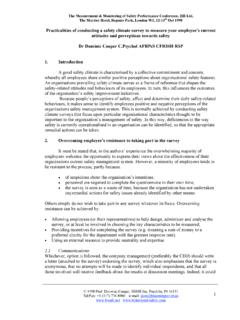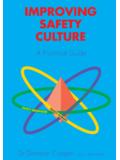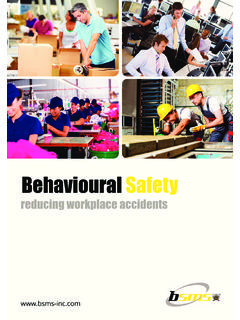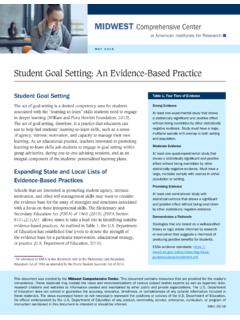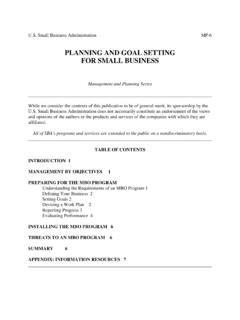Transcription of Goal-Setting For Safety
1 Goal-Setting For Safety Published in: The Safety and Health Practitioner, November 1993. Dr Dominic Cooper AFBPsS MASSE MIIRSM FIOSH FRSH B-Safe Management Solutions Inc, 6648 East State Road 44, Franklin, IN 46131, USA. Introduction Following the Piper Alpha disaster and the subsequent public enquiry, Lord Cullen recommended that the Health and Safety Executive shift its emphasis towards an 'auditing of systems' approach, rather than an 'inspection of sites' approach. Although primarily aimed at the offshore industry, the implications for all industries are that management will have to develop Safety management systems that encourage safe working practices, rather than responding to the consequences of accidents. In order to facilitate the recommendations, the Cullen report (1990) explicitly advocated the use of Goal-Setting as a technique that might be more widely used. It could be argued that any and all attempts at improving Safety performance at work inevitably incorporate the notion of achieving particular goals or targets.
2 For example, all employees new to a workplace must complete a process of Safety induction; all operatives on a building site must undergo 'tool-box' training once a week; all construction site management must complete a formal health and Safety course; every sub-contractor must submit a written Safety policy prior to being awarded a contract, etc., are all targets or goals . Thus, most people involved in Safety at work try and attain goals or targets, even if they are not explicitly aware of it. It is typically the case, however, that although most people understand what Goal-Setting means, (ie setting targets or objectives), very few are aware of the optimal ways to set goals or the contingent factors that might affect a successful conclusion. Core findings Goal setting theory is primarily aimed at task performance in the workplace, and is based on the central idea that goals are the immediate, though not only, cause of human action (Locke & Latham, 1990).
3 By their very nature, goals motivate people to focus their attention and action, to try harder and to persist until a desired future state has been reached. The usefulness of Goal-Setting for increasing task performance has been demonstrated in many countries, across a variety of occupations. It is critical, however, that a goal matches the performance criteria being monitored, ( attaining the goal of improved Safety in the workplace is measured by monitoring and assessing several Safety performance indicators). If a goal is accepted by employees, virtually any type of behaviour that is able to be measured can be improved. The main aim of any goal is to place sufficient demands and challenges upon people in order to motivate them to achieve higher levels of performance. The amount of effort and energy expended to achieve a goal, depends to a great extent on how much of a challenge the goal represents to those who are trying to reach it.
4 In general, assuming the goal is accepted and people are committed, the more of a challenge the goal is, the more effort people will exert to reach the goal. This is because when goals are acted upon, more attention is directed to the activity specified by the goal, than other non-goal related activities. Demonstrations of this effect are provided in a Goal-Setting study conducted in a west country factory (Cooper et al, 1993), whereby the occurrence of accidents related to specific behaviours for which goals had been set, reduced considerably. Conversely, the occurrence of accidents related to other Safety behaviours, for which no goals had been set, continued at its previous rate, and in some departments increased. Similarly, in an HSE funded Goal-Setting study in the construction industry (Duff et al, 1993), improvements in Safety performance were found in scaffolding, access to heights and housekeeping categories for which goals had been set, whereas no appreciable improvement was found in the personal protective equipment category for which no goals were set.
5 It should be recognised, however, that people will be reluctant to try and reach a goal that they think is unrealistic or impossible to achieve ( Zero-accidents in the workplace, or 100% Safety performance). If the goal is thought to be unrealistic, people's commitment to reach the goal will be adversely affected, to the extent that the goal will be rejected. Thus, unrealistic goals tend to demotivate people. This raises the question of how do we know when a goal is demanding or challenging, but not beyond the realms of achievement? Determining the optimal level of a challenging goal can be done in two ways. The first method is to compare the high performance levels achieved by relatively few individuals, with the average performance levels usually obtained by the majority of employees. The average high performance level then becomes the goal. This method allows the goal to remain achievable, as well as providing a challenge to the majority.
6 The second method entails establishing the current performance levels of a group as a whole, to provide a baseline with which future performance can be compared. The workgroup as a whole then discusses what level the goal should be, until consensus and agreement is reached. In order to direct peoples focus of attention more effectively, goals should be stated in very specific terms ( all ladders placed on a site must be long enough to be at least 5 rungs above a working platform), rather than be too vague or general ( ladders that are too short should not be used). Although this may sound little more than applied common sense, in practice, goals are rarely implemented correctly. Typically, goals are set that are too broad. This allows people to interpret the effectiveness of their performance against a multitude of performance indicators, which may or may not be compatible with the intended performance improvements.
7 In contrast, a specific goal only allows comparisons with specific aspects of performance. Therefore, a specific, challenging goal clarifies what constitutes good performance and removes ambiguity. This leads to maximum arousal and causes people to focus upon the particular activities and resources needed to achieve a goal. Another benefit of specific goals is that most people are reassured by, and more satisfied, from having a clear appreciation of what is expected of them. A specific, challenging goal may also affect performance by motivating people to find ways to overcome obstacles, usually by changing their planning and approach towards the task goal. An example of this is provided from the Broadgate construction development in London. Management's goal was that the working conditions should be second-to-none. Because of the high profile nature of the site, management placed high emphasis on the importance of working safely.
8 Throughout the duration of the site, it was found that many sub-contractors developed their own Safety features, in addition to those prescribed by the main contractor. These included drilling extra holes in steelwork to provide anchor points for fixing Safety harnesses; designing simple toeboard clips, etc. This and other research related evidence shows that provided people are committed, striving for a specific, difficult goal typically stimulates creative thinking and problem solving, to ensure success. Contingent Factors Although a goal should be challenging, realistic and expressed in very specific terms, being confronted with a challenge does not always guarantee high performance. At least five factors are known to affect subsequent performance. These are: [1] an individuals or workgroups ability; [2] their choice of how difficult the goal should be; [3] their commitment to reaching the goal; [4] how confident they are in being able to reach a goal; [5] how complex the task goal is; and [6] whether or not they are provided with information feedback as to how well they are performing in relation to the goal.
9 An individuals or workgroups ability to perform a task will obviously limit the extent to which a task goal will be reached. Ability is normally judged by how well someone has done on the same or similar tasks in the past. Within the context of Safety , insufficient ability is more likely to be related to a lack of knowledge about the Safety aspects of a job, rather than a lack of ability per se. This can be addressed by the provision of Safety training that is focused on the specific elements or behaviours necessary to allow people to achieve their Safety goals . Again, although this sounds obvious, it is often the case that Safety training covers a wide range of events or situations that typically are not relevant to the individuals being trained. Examples of this include a company that provided 'tool-box' talks to all operatives on a specific topic every week, on every one of their sites.
10 Even when the activities incorporated in a particular week s topic were not occurring on any of their sites, or the topic was not relevant to the particular trades on site, the training sessions still went ahead. Providing Safety training that is not particularly relevant to the task at hand is not only likely to trivialise Safety , but is also likely to demotivate those involved. The choice of how difficult a goal should be, will be influenced by what the individual or workgroup would ideally like to achieve, what they expect to achieve, and what is believed to be the minimum that should be achieved. A goal determined by ideals is more than likely to be based upon wishful thinking more than reality, and represents what could happen if everything went right. This type of goal is typically reflected through mission or vision statements issued by boardroom executives, which state that Safety is a top priority; that the company has set a goal of zero-accidents and that all employees should behave safely and follow company Safety policies.
